Dupplin Cross
Cross (Pictish)
Site Name Dupplin Cross
Classification Cross (Pictish)
Alternative Name(s) Dupplin Castle Policies; Cross Park; Bankhead
Canmore ID 26594
Site Number NO01NE 6
NGR NO 05051 18969
NGR Description removed to NO 01905 14490
Datum OSGB36 - NGR
Permalink http://canmore.org.uk/site/26594




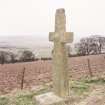
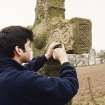

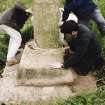






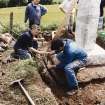

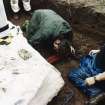

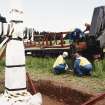

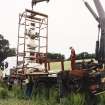
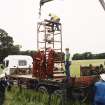

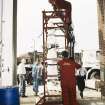












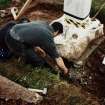


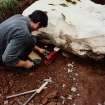















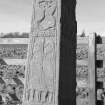
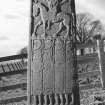
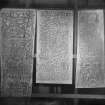






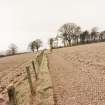









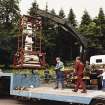



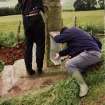






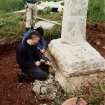





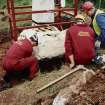

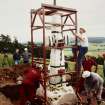







First 100 images shown. See the Collections panel (below) for a link to all digital images.
- Council Perth And Kinross
- Parish Forteviot
- Former Region Tayside
- Former District Perth And Kinross
- Former County Perthshire
This cross originally stood 750m SW of Dupplin Castle but it was moved for reasons of conservation and is now on display in nearby St Serf's Church, Dunning. Dating from the 9th century, all four faces of the free-standing sandstone cross are carved in relief with depictions of beasts, warriors armed with spears and a figure playing a harp, which may represent King David. Other carvings include interlaced-work, knots and spiral patterns.
Information from RCAHMS (SC) 29 August 2007
Dupplin, Perthshire, free-standing cross
Measurements: H 2.92m (2.62m above the base), span of side-arms 0.94m, depth at centre of cross-head 0.38m; base L 1.4m, H 0.6m, W 1.15m
Stone type: old red sandstone
Place of discovery: NO 0505 1896
Present location: within St Serf’s Church, Dunning.
Evidence for discovery: recorded in situ in the 1830s by Skene, set on a terrace to the immediate north of the River Earn.
Present condition: weathered.
Description
This monument consists of a cross set in a base stone, both carved from single blocks of sandstone. The cross faced east and was set into a socket at the west end of the base, leaving a small platform in front of it. The socket is outlined by a plain moulding, and there are traces of interlace around it. All five faces of the cross are carved in relief, as are the undersides of the arms. The edges have a roll moulding, which on faces A and C become scrolls at the cusping of the arms of the cross-head, with an inner narrow roll moulding on faces B, C and D. Face E at the top of the cross is carved with a tegulated finial, now very weathered.
The cross-head on face A (east face) is dominated by a prominent central boss with corrugated sides, which is enclosed by two plant scrolls, the bases of which are in the lower arms and which expand into the side arms and the upper arm. The top arm is elongated by a panel of diagonal key pattern. Beneath the cross-head, the top panel of the shaft contains a warrior on horseback, facing left, above a panel into which four foot soldiers are compressed, all facing left and carrying spears and wearing shields on straps around their necks. They wear knee-length tunics with decorated hems. In the panels beneath them are two leaping hounds. Anyone kneeling in front of face A could see the two animals carved on the undersides of the side arms.
Narrow face B (south face) displays four panels of interlace pattern on the cross-head, including diagonal key-pattern on the end of the side-arm, and three panels on the shaft. The uppermost contains an animal with head turned back to bite its own tail, and the panel below a musician seated on a chair playing a large triangular harp, and at the base a panel with knotwork.
The cross-head on face C (west face) has a deep border of ribbing around a boss ornamented with step pattern, and the decoration on the arms combines animal-headed interlace with double spirals. The shaft is divided into three panels, the uppermost of which contains a worn seven-line Latin inscription. This mentions the historically documented king, Custantin mac Forcussa (AD 789-820). The central panel contains four pairs of plump birds, while the lower panel is carved with a naked figure wrestling with the jaws of a lion above what appear to be a boar and an upright bear.
Date: early ninth century.
Narrow face D (north face)has panels of curvilinear and geometric interlace and step pattern on the cross-head. On the shaft are three panels containing an animal above a great triangular harp played by a seated figure. The lowest panel contains double-ribbon interlace.
References: Skene 1832, 6; ECMS pt 3, 319-21; Ewart et al 2007.
Compiled by A Ritchie 2016
NO01NE 6 05051 18969
(NO 0505 1897) Stone Cross (NR)
Supposed Site of the Battle of Dupplin (NR) (AD. 1332): Cross (NR)
OS 6" map, Perthshire, 2nd ed., (1901); OS 6" map, (1959)
The site of the Battle of Dupplin, between Mar, the Scottish Regent, and Balliol of England in AD 1332 is marked by a cross (Burrows 1932) 8'6" high, with sculptures on all four sides.
J Stuart 1856; A Lang 1909; E J Burrows 1932.
The cross is as described above.
Visited by OS (J T T) 2 November 1965.
This sculptured cross stands 750m SW of Dupplin Castle (NO01NE 22.00) and 400m ENE of Bankhead steading (NO01NW 114) in a field called 'Cross Park'. It is a free-standing cross of Old Red Sandstone, measuring 2.62m high and 0.94m wide across the arms. The shaft is 0.46m by 0.33m wide wide at the bottom, tapering upwards to 0.39m by 0.29m at the top of the shaft, and 0.24m at the apex of the cross. All four faces are sculptured in relief. The numbers in brackets refer to the illustrations published in Anderson and Allen:
Front. The head of the cross is surrounded by a roll-moulding (which makes single spiral curves at each of the points of the cusped hollows between the arms) and has a raised circular boss in the centre ornamented with a diaper key-pattern (No. 1015) and ribbed border. Surrounding the central boss, the four arms form one panel, containing spiral-work (No. 1054), and some other ornament which is too defaced to be deciphered. The shaft is divided into three panels (the two upper ones being separated by a border of square key-pattern (No. 899): the top panel contains defaced sculpture; the middle panel, a raised circular boss of interlaced-work (No. 789) surrounded by four pairs of birds with their beaks and legs crossed and interlaced; and the bottom panel, David rending the lion?s jaws, and beasts in the background.
Right side. On the upper arm there are two panels, the upper containing interlaced-work (No. 533); and the lower a diagonal key-pattern (No.952). On the end of the right arm, a single panel contains a diaper key pattern (No.1004). On the under surface of the right arm, there is a single beast with its head bent back biting its tail. On the lower arm, a single panel contains a mixed key and spiral-pattern (No. 950), with a narrow horizontal border of square key-pattern (No. 887) below it. On the shaft there are three panels, the upper two separated by a horizontal band of diagonal key-pattern (No. 926): the top panel and contains a pair of beasts sitting on their ches facing each other, with their paws crossed over on each other's necks; on the middle, there are two warriors on foot, armed with spears, with is ornamented with a border of square key-pattern (No. 887); and at the bottom there is a triquetra knot (No. 802).
Back. The head of the cross has a similar moulding round it to that on the front, and a raised circular boss in the centre, although the ornament on this has been defaced. It is divided into two panels, containing on the upper part of the top arm, a diagonal key-pattern (No. 952); and on the remaining part of the head, scroll foliage. The shaft is divided into three panels separated by bands of square key-patterns (Nos. 887 and 890): The top panel contains a warrior on horseback armed with a spear; the middle panel, four foot-soldiers armed with spears and circular shields; and the bottom, a hound and another animal.
Left side. On the upper arm there are two panels, the top one containing interlaced-work (No. 538) and the bottom one a square key-pattern (No. 909). On the end of the right arm, there is a single panel containing a diagonal key-pattern (No.951). On the under side of the left arm, a single panel contains a beast with its head bent back. On the lower arm, a single panel contains interlaced-work (No. 378). On the shaft there are three panels, the upper two separated by a horizontal band of square key-pattern (No. 890): the top panel contains a beast biting its tail, which is interlaced beneath the body; the middle panel depicts a man seated on a chair playing a harp (perhaps King David); and the bottom panel has a six-cord plait with a single break in the middle.
Visited by RCAHMS (IF), November 1995.
JR Allen and J Anderson 1903.
NO 050 189 Excavations were conducted at the site of the Dupplin Cross in Strathearn (NMRS NO01NE 6), both before and after its removal for conservation. This was an attempt to record and date the context of the cross in order to resolve the dispute as to whether the cross remained in its original position, or had been moved since its creation in the 9th century AD. The results of the excavation proved inconclusive, although it could be shown that the cross has been in the general location since the late 17th century at least.
Sponsor: Historic Scotland
A Radley and A Dunn 1999
Descheduled.
Information from Historic Scotland, Certificate of Exclusion from Schedule dated 22 January 2001.
The Dupplin Cross has now been removed from NO 0505 1897 and placed on display in St Serf's Church, Dunning (NO01SW 13.00, NO 01905 14490).
Information from RCAHMS (PM) 4 March 2005
Antiquarian Observation (1832)
Field Visit (2 November 1965)
The cross is as described.
Visited by OS (J T T) 2 November 1965.
Field Visit (1 November 1995 - 30 November 1995)
This sculptured cross stands 750m SW of Dupplin Castle (NO01NE 22.00) and 400m ENE of Bankhead steading (NO01NW 114) in a field called 'Cross Park'. It is a free-standing cross of Old Red Sandstone, measuring 2.62m high and 0.94m wide across the arms. The shaft is 0.46m by 0.33m wide wide at the bottom, tapering upwards to 0.39m by 0.29m at the top of the shaft, and 0.24m at the apex of the cross. All four faces are sculptured in relief. The numbers in brackets refer to the illustrations published in Anderson and Allen:
Front. The head of the cross is surrounded by a roll-moulding (which makes single spiral curves at each of the points of the cusped hollows between the arms) and has a raised circular boss in the centre ornamented with a diaper key-pattern (No. 1015) and ribbed border. Surrounding the central boss, the four arms form one panel, containing spiral-work (No. 1054), and some other ornament which is too defaced to be deciphered. The shaft is divided into three panels (the two upper ones being separated by a border of square key-pattern (No. 899): the top panel contains defaced sculpture; the middle panel, a raised circular boss of interlaced-work (No. 789) surrounded by four pairs of birds with their beaks and legs crossed and interlaced; and the bottom panel, David rending the lion?s jaws, and beasts in the background.
Right side. On the upper arm there are two panels, the upper containing interlaced-work (No. 533); and the lower a diagonal key-pattern (No.952). On the end of the right arm, a single panel contains a diaper key pattern (No.1004). On the under surface of the right arm, there is a single beast with its head bent back biting its tail. On the lower arm, a single panel contains a mixed key and spiral-pattern (No. 950), with a narrow horizontal border of square key-pattern (No. 887) below it. On the shaft there are three panels, the upper two separated by a horizontal band of diagonal key-pattern (No. 926): the top panel and contains a pair of beasts sitting on their ches facing each other, with their paws crossed over on each other's necks; on the middle, there are two warriors on foot, armed with spears, with is ornamented with a border of square key-pattern (No. 887); and at the bottom there is a triquetra knot (No. 802).
Back. The head of the cross has a similar moulding round it to that on the front, and a raised circular boss in the centre, although the ornament on this has been defaced. It is divided into two panels, containing on the upper part of the top arm, a diagonal key-pattern (No. 952); and on the remaining part of the head, scroll foliage. The shaft is divided into three panels separated by bands of square key-patterns (Nos. 887 and 890): The top panel contains a warrior on horseback armed with a spear; the middle panel, four foot-soldiers armed with spears and circular shields; and the bottom, a hound and another animal.
Left side. On the upper arm there are two panels, the top one containing interlaced-work (No. 538) and the bottom one a square key-pattern (No. 909). On the end of the right arm, there is a single panel containing a diagonal key-pattern (No.951). On the under side of the left arm, a single panel contains a beast with its head bent back. On the lower arm, a single panel contains interlaced-work (No. 378). On the shaft there are three panels, the upper two separated by a horizontal band of square key-pattern (No. 890): the top panel contains a beast biting its tail, which is interlaced beneath the body; the middle panel depicts a man seated on a chair playing a harp (perhaps King David); and the bottom panel has a six-cord plait with a single break in the middle.
Photographic Survey (1997)
Excavation (1 April 1998 - 2 April 1998)
NO 050 189 Kirkdale Archaeology were asked to excavate a trench around the Dupplin cross (NO 05051895), with the aim of determining how large its' base stone is, and how much concrete had been placed around it in the 1920's. At the same time it was hoped that it might be possible to determine when the stone had been erected in its' current location. This work was to facilitate the removal of the cross for conservation.
Sponsor: Historic Scotland
A Radley & A Dunn 1998
Kirkdale Archaeology
Excavation (29 June 1998 - 3 July 1998)
Monitoring and Excavation during and after the removal of the cross & socket base stone. The project involved the preparation for, and the lifting of the cross and basal socket stone, and the excavation of the remaining material to subsoil horizons. Following this, extension trenches were excavated northwards from the NE corner, and westwards from the centre of the W baulk. The trench and sections were graphically and photographically recorded.
It was not possible to ascertain whether the cross had been moved from an original position in the 18th century, but it was clear that the 1925 work had in all likelihood involved the removal of the stone from its basal socket, and the clearing and re-grouting and pinning of the latter. The only dating evidence recovered comprised late 20th-century bottle glass, and later 18th- 19th-century stoneware (3 sherds) in the W sondage
Sponsor: Historic Scotland
A Radley & A Dunn 1998
Kirkdale Archaeology
Note (4 March 2005)
The Dupplin Cross has now been removed from NO 0505 1897 and placed on display in St Serf's Church, Dunning (NO01SW 13.00, NO 01905 14490).
Information from RCAHMS (PMcK) 4 March 2005









































































































